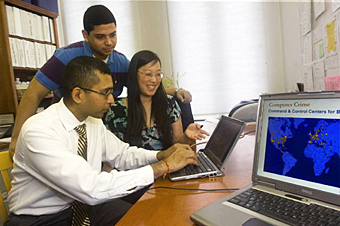UAlbany School of Business Professor Wins Grant to Reduce Idling Time at Traffic Lights
Results May Reduce Carbon Emissions, Lessen Driver Frustration
ALBANY, N.Y. (October 26, 2010) -- UAlbany School of Business Associate Professor Sanjay Goel has won a $378,375 grant from the James S. McDonnell Foundation to study how traffic lights can be more efficiently organized so that drivers save time and gas, thereby reducing carbon emissions, and experience less frustration while waiting for the light to change.
 |
Associate Professor Sanjay Goel, seated with students, is studying how traffic lights can be more efficiently organized so that drivers can save time and gas. (Photo Mark Schmidt) |
"This is a fantastic research project because it is strong theoretically; at the same time it is practical and impacts the common experience for all drivers," said Goel, a faculty member in the information technology management department. Less time spent idling one's car engine benefits the environment through reduced carbon emissions.
Every driver knows the stop-and-go feeling of hitting five or six red lights in a row. Groups of lights can already be synchronized, but depending on the direction of travel, a driver could hit all greens or all reds. The goal of the project is to improve coordination through a self-organizing system.
Goel draws a parallel between more efficient traffic lights and ant colonies, which already have a self-organizing system. Each ant picks up information from its neighbor, and together they can build a raft to carry their queen and her eggs, by entangling their legs. In the same manner, they can build a bridge in a single file. If one ant leaves the lineup, the cues from neighbor to neighbor continue and the line is unbroken.
Goel believes that each traffic light, like each ant, should make its own decision to communicate with the next light. That way, a driver crossing the intersection at midnight wouldn't have to wait for long minutes at a red light while there is no other traffic.
The grant is from the James S. McDonnell Foundation 21st Century Science Initiative in Studying Complex Systems-Research Award.
"It's a rare win-win," said James S. McDonnell Foundation Vice President Susan M. Fitzpatrick, Ph.D. "The Foundation's goals include supporting the acquisition of new knowledge and using knowledge to improve the quality of life. We see this project as fulfilling both – how terrific if complex systems science could relieve one of the most frustrating aspects of transportation."
Initial work has shown that self-organization in traffic lights would be very effective. At this point in the project, Goel is most interested in knowing what will not work in organizing traffic lights. That answer will lead him to "deeper investigation of such a system so that we find the most efficient way to get it to work," said Goel, whose research areas straddle system optimization, resiliency of complex systems, cyber security, and cyber warfare.
"The goal is to develop self-organizing algorithms and conduct simulation and modeling that would involve selection of intersections in Albany to test some algorithms," said Goel. "The focus of the study is to understand the limitations of this approach and find out where such techniques can fail or under what conditions we may get bottlenecks or chaos in traffic," he said.
Goel is looking for just the right intersections. "We will pick a variety of places where there is fast-moving traffic in the city," he said.
Goel was assisted in applying for the grant by Winsome Foderingham and Carol Olechowski of the Development office, and by doctoral student Damira Pon of LaGrangeville, N.Y.
![]() For more news, subscribe to UAlbany's RSS headline feeds
For more news, subscribe to UAlbany's RSS headline feeds
Educationally and culturally, the University at Albany-SUNY puts "The World Within Reach" for its 18,000 students. An internationally recognized research university with 58 undergraduate majors and 128 graduate degree programs, UAlbany is a leader among all New York State colleges and universities in such diverse fields as public policy, nanotechnology and criminal justice. With a curriculum enhanced by 300 study-abroad opportunities, UAlbany launches great careers. For more information about this globally ranked University, visit https://www.albany.edu/. For UAlbany's extensive roster of faculty experts, visit www.albany.edu/news/experts.shtml.


